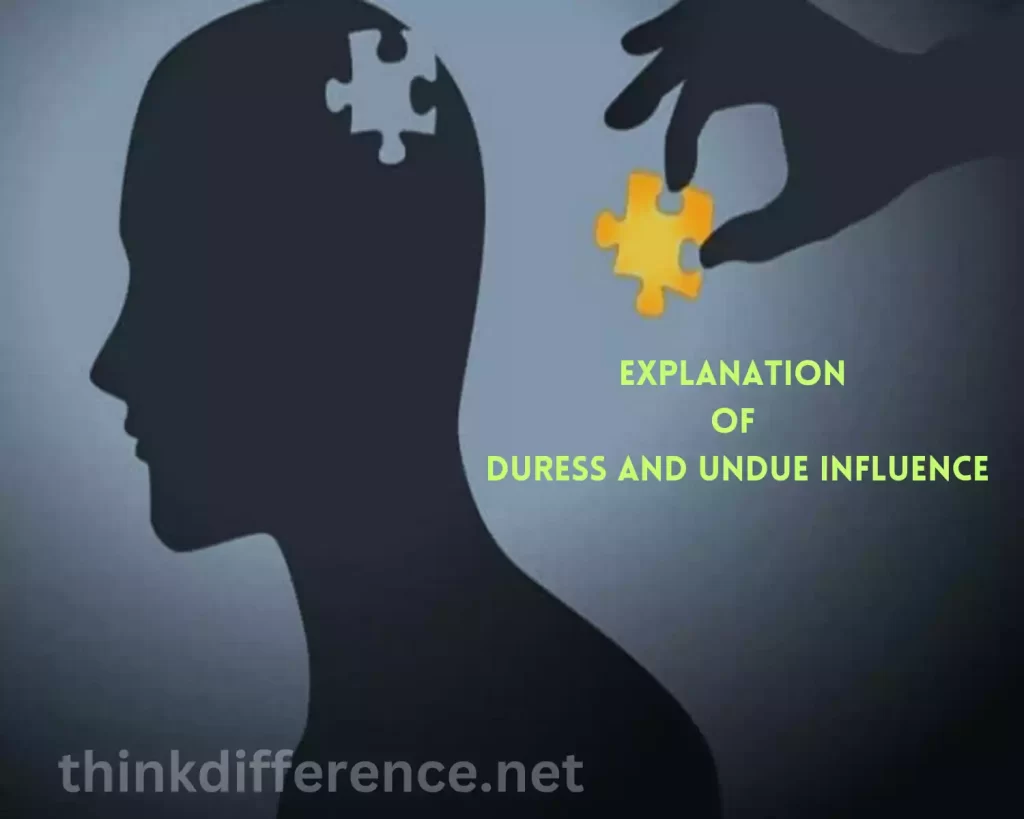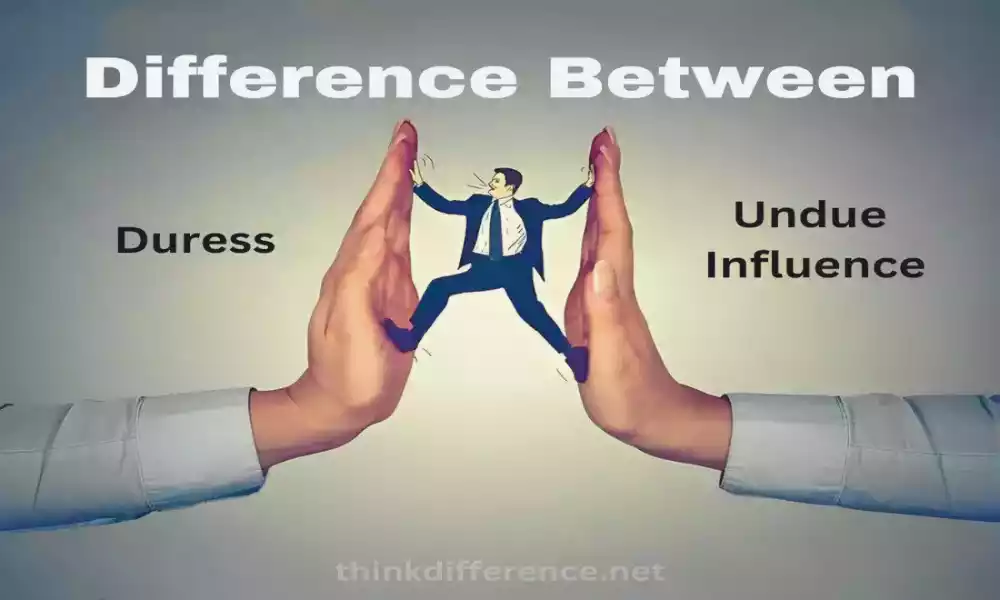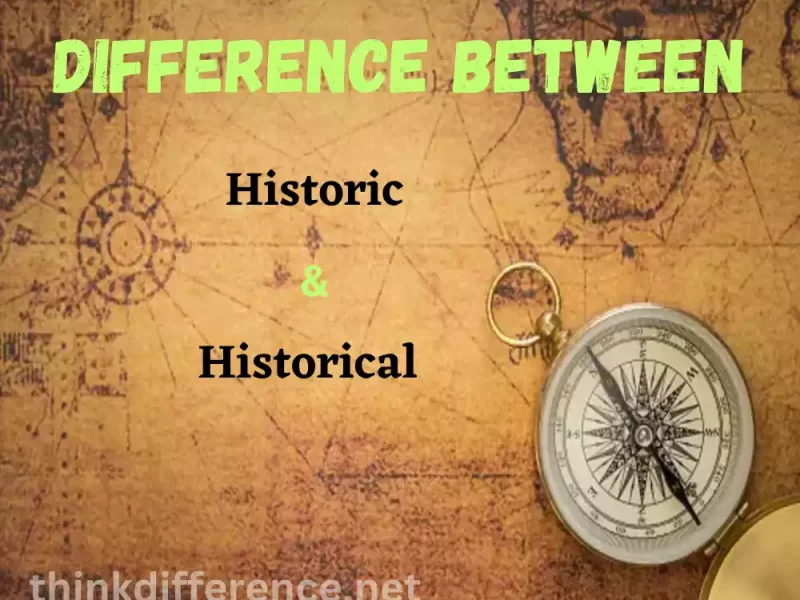Explanation of Duress and Undue Influence
Duress and Undue Influence refer to instances when someone forces another into doing something against their will or influences them into taking an action against their wishes. Each term contains subtle distinctions. Duress occurs when someone is coerced into doing something they do not wish to do.
It could come in the form of physical force, economic strain, or emotional manipulation and the threat is usually clear such as harm coming to those close or potential violence against themselves or threats made.

Unfair influence is an indirect form of coercion. When someone uses their power or influence to convince another individual to do something they wouldn’t normally do, such as manipulating someone vulnerable, taking advantage of an authority position or trust relationship, or exploiting an individual’s age or disability, undue influence occurs.
Parties involved are key in differentiating duress from undue pressure. When someone uses force or threats against another, their perpetrator is usually readily apparent whereas in instances of undue pressure, the culprit may seem beneficial or supportive to their victim.
Legal consequences vary between undue pressure and duress. Duress is generally used as a defense against criminal charges thus allowing someone forced into committing illegal acts by duress to avoid prosecution. Unfair influence tends to be considered more of a civil issue, it could invalidate contracts made under pressure and therefore nullify them altogether.
Definition of Duress
Anyone who can demonstrate to a court that they were subjected to coercive conditions when signing documents under direct or indirect threat is considered under duress. To demonstrate duress, victims must provide details as to the exact circumstances.

That leads them to act against their will attorneys often use duress as grounds against defendants accused of sexually exploiting women or forcing them into performing unlawful acts against their will, while juries use duress as justification when reaching decisions against illegal acts committed against others.
It has many uses within the law itself as well as being applied across cases in many different scenarios involving illegal acts committed against individuals as it provides for reduced penalties against defendants accused. Its widespread usage within law makes its application in many different contexts than just one.
Definition of Undue Influence
Undue Influence occurs when someone attempts to gain an advantage by using their position of power to obtain any advantage that might benefit them in any contractual agreement.

When someone believes he/she has been wronged in such an arrangement, their lawyer can use court evidence of undue pressure being exerted upon another party using undue force against them to secure advantages in that contract as proof. Should such pressure exist between contract partners then the court could declare this contract null and void and award damages where applicable.
Importance of understanding the difference between duress and undue influence
Understanding the differences between duress and unjustified influence is vital as each has different legal ramifications. Many jurisdictions recognize duress as a viable defense in instances when someone is forced into doing something against their will or coerced to commit acts that they don’t wish for, such as coercion being used against defendants as an attempt at exoneration or reduced sentence.
But, should their claim of duress fail and instead it was caused by undue influence then full legal consequences may ensue for such actions taken under duress. Unwitting victims may not recognize the extent of manipulation being used against them, leading them to sign agreements or contracts that do not serve their interests.
They would have rejected had it not been for this unfair influence. Recognizing abusive influences as soon as they occur can help ensure contracts and agreements will be fair and equitable.
Understanding the difference between undue pressure and duress is vital for legal professionals such as judges, lawyers, and law-enforcement officials who may encounter these situations in their work. Recognizing duress from undue influence helps ensure justice is served while keeping victims protected against coercion or manipulative tactics.
Understanding the difference between undue pressure and duress is vital in protecting people against manipulation, coercion, and legal proceedings that violate fairness as well as in encouraging ethical, equitable, and moral behavior practices.
Comparison Between Duress and Undue Influence
Here are the main distinctions between duress & undue Influence:
| Aspect | Duress | Undue Influence |
|---|---|---|
| Definition | Involves the use of threats, coercion, or unlawful pressure to force someone into a contract against their will. | I invite |
| Nature of Pressure | Involves direct and often overt threats or physical coercion. | Typically involves subtle and psychological tactics or emotional manipulation. |
| Parties Involved | Can occur between parties of equal or unequal power. | Usually occurs when there’s a significant power imbalance between the parties. |
| Burden of Proof | The burden of proof typically falls on the party claiming duress to demonstrate the presence of threats or coercion. | The party alleging undue influence usually bears the burden of proving that they were unduly influenced and lacked free will in entering the contract. |
| Presumption | Duress is generally not presumed the party alleging duress must provide evidence. | Undue influence may be presumed in certain relationships, like attorney-client or guardian-ward relationships, making it easier for the influenced party to establish a case. |
| Examples | Physical threats, economic pressure, blackmail, unlawful confinement, or threats to reputation. | Exploitation of the elderly, family pressure, charismatic leaders manipulating followers, psychological manipulation, or misuse of authority. |
| Contract Outcome | Contracts entered into under duress are often voidable at the option of the aggrieved party. | Contracts tainted by undue influence are also usually voidable, with remedies available to the party unduly influenced. |
Similarities between Duress and Undue Influence
While duress and unjustified influence differ significantly, they do share some similarities that should not be overlooked, including:
- Both involve coercion: Duress and unjustified influence both involve coercion people forced into doing something they do not wish for are effectively being coerced to comply.
- Both can invalidate consent: Both situations could invalidate consent agreements reached between victims and providers through coercion or manipulation, effectively nullifying such arrangements.
- Both scenarios could result in invalidations or non-enforcement of contracts and agreements: If these were signed under duress or undue pressure, their enforceability may be declared null or void and declared null and void.
- Both can have legal consequences: Legal implications associated with duress or undue pressure can have grave legal repercussions criminal prosecution and civil liability may all arise as possible outcomes of these situations.
- Both can involve a power imbalance: Both scenarios may be defined by an imbalance of power between parties involved, leading to undue pressure or duress for one party in comparison with another, leading them into exploitative and manipulative behaviors and situations.
Duress and unjustified influence differ considerably when it comes to their impact on contracts, consent, and legal consequences yet both techniques share similarities that affect these areas.
International Perspectives and Ethical Considerations
International Perspectives on Duress and Undue Influence:
The issue of duress and unjustified influence is one of the issues that cross national boundaries or legal systems. Although the precise legal definitions and approaches differ from one country to another, the basic purpose is always the same: ensuring the integrity and fairness of contracts.
Some countries, such as such as the United States and the United Kingdom have well-established legal frameworks for addressing these issues. They are usually governed by vast statutes and case law. Others, specifically those that have civil law traditions might have different approaches but they all share the purpose of protecting people from repression in contracts.
Ethical Considerations in Addressing Duress and Undue Influence:
The ethical considerations are crucial when it comes to dealing with duress and unjust influence. These issues touch on the fundamental principles of autonomy, fairness, and respect for individual rights. Parties to contracts must uphold the integrity and transparency of their contracts while avoiding exploiting weaknesses or using manipulative techniques.
Legal professionals are bound by an ethical obligation to ensure that their clients don’t use coercion when negotiating contracts. In addition, public awareness campaigns need to not only educate people about their rights as legal citizens but also foster a sense of moral accountability to ensure fair contract practices.
Legal ethics in the profession, along with public education initiatives can help create an ethical and fair legal and business environment globally and domestically.
Examples of duress and undue influence in contract law
Duress under Contract Law: Duress in contract law is when one of the parties to a contract is coerced into signing a contract by threats, coercion or other unlawful pressure, thereby making their agreement non-voluntary.
For example, the company owner is threatening physical injury to a supplier unless they are willing to provide goods at a ridiculously low price, it is considered to be duress. If a person is compelled to sign an agreement by anyone who threatens to disclose sensitive information, this is an example of duress.
Courts typically cancel contracts signed under duress to prevent those from being unjustly forced to sign contracts against their will.
Undue influence within Contract Law: Undue influence in contract law occurs when one party makes use of their position of authority, trust, or manipulation of emotions to exert influence over another and force the party being influenced to sign an agreement they would never have entered into otherwise.
A case of undue influence might be an influential family member who pressures the financially dependent member of the family into signing a document that transfers their assets or property at a disproportionately low cost.
In the same way, if an inspirational religious leader convinces his followers to donate their wealth by offering spiritual rewards this could also be an instance of unjust influence. The courts can invalidate contracts that have been tainted with undue influence, to safeguard vulnerable parties from being exploited.
Public Awareness and Education
- Legal Aid and Support: It is crucial to stress the accessibility of legal aid as well as other support services for those who suspect they’ve fallen victim to pressure or unjustified influence. Many countries provide legal clinics as well as pro bono assistance to help affected people through the review of contracts and help with legal action if necessary.
- Government and Regulatory Involvement: The regulatory and government bodies have a key role to play in educating the public and enforcing the law against abuse of power and dubious influence. Public awareness campaigns catalyze enticing individuals to file a complaint while also fostering accountability in addition to ensuring that people who engage in coercive actions can be accountable.
- Collaboration with non-profits and advocacy Groups: Non-profit and advocacy organizations often advocate for the protection of vulnerable people from coercive contracts. The collaboration efforts of these organizations as well as public education campaigns can enhance messages and offer additional assistance and resources for the most vulnerable.
- Measuring Impact: Evaluation of the effectiveness of education and public awareness initiatives is vital. Monitoring indicators such as increased reports of coercion-related cases and a decrease in the number of coercive contracts, and better legal outcomes allow us to assess the effectiveness of these initiatives.
- Challenges and Future Directions: We are aware of the challenges that come with preventing duress and unjust influence. They include tackling the ever-changing ways of coercion that are being used in the age of technology and actively addressing new tactics used by shady actors.
Conclusion
Duress and Undue Influence pressure are two forms of coercion or manipulation, yet their nature, parties involved, legal consequences, and timing differ significantly.
Understanding these variations between duress and undue influence is paramount to safeguarding people from coercion while upholding fairness in legal proceedings, upholding ethical, equitable, and moral practices, and encouraging ethical, equitable, and moral behaviors in practice.
Both forms can invalidate agreements leading to legal consequences these two coercion concepts differ considerably in coercion used and parties involved – legal professionals as individuals can both benefit from becoming aware of these differences while safeguarding themselves against coercion.



